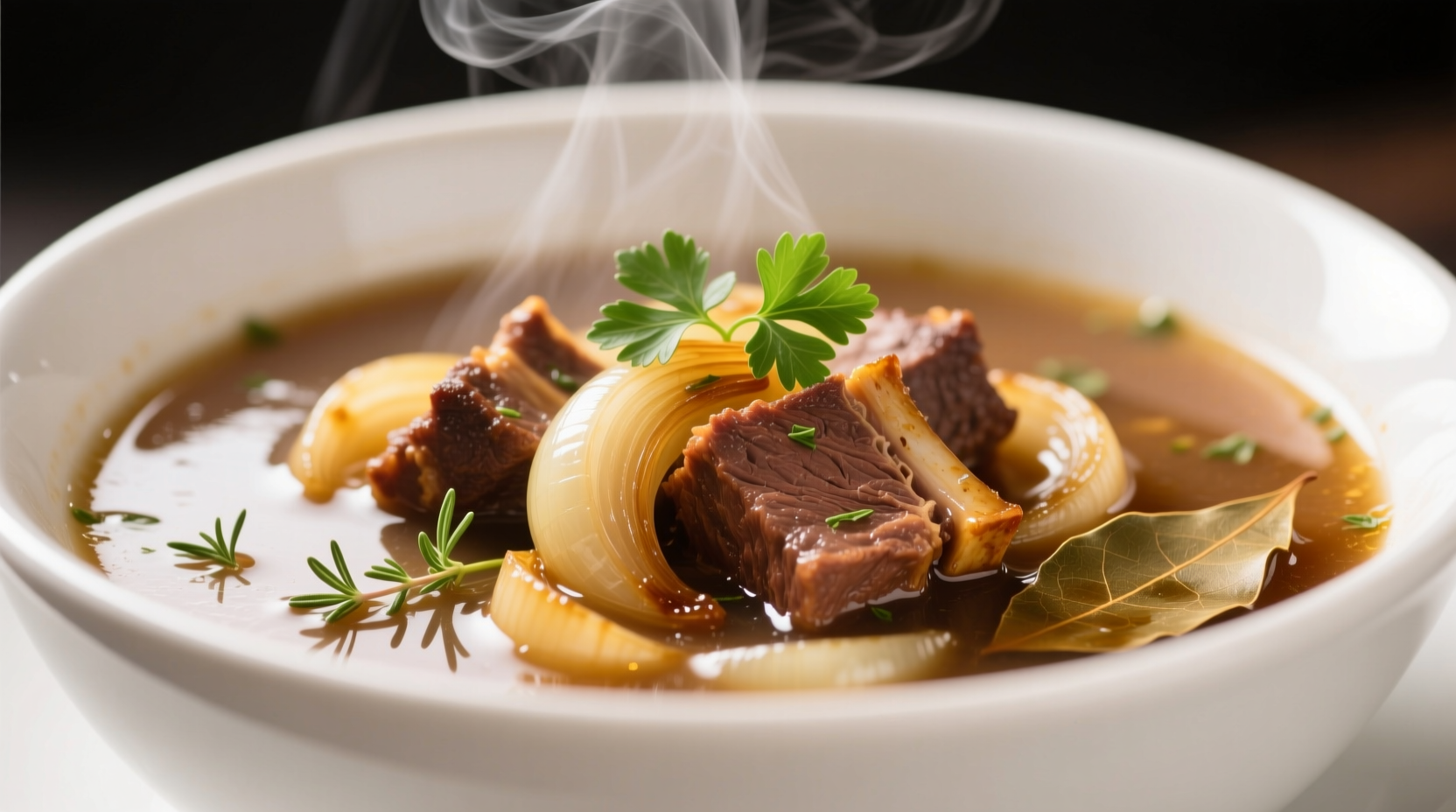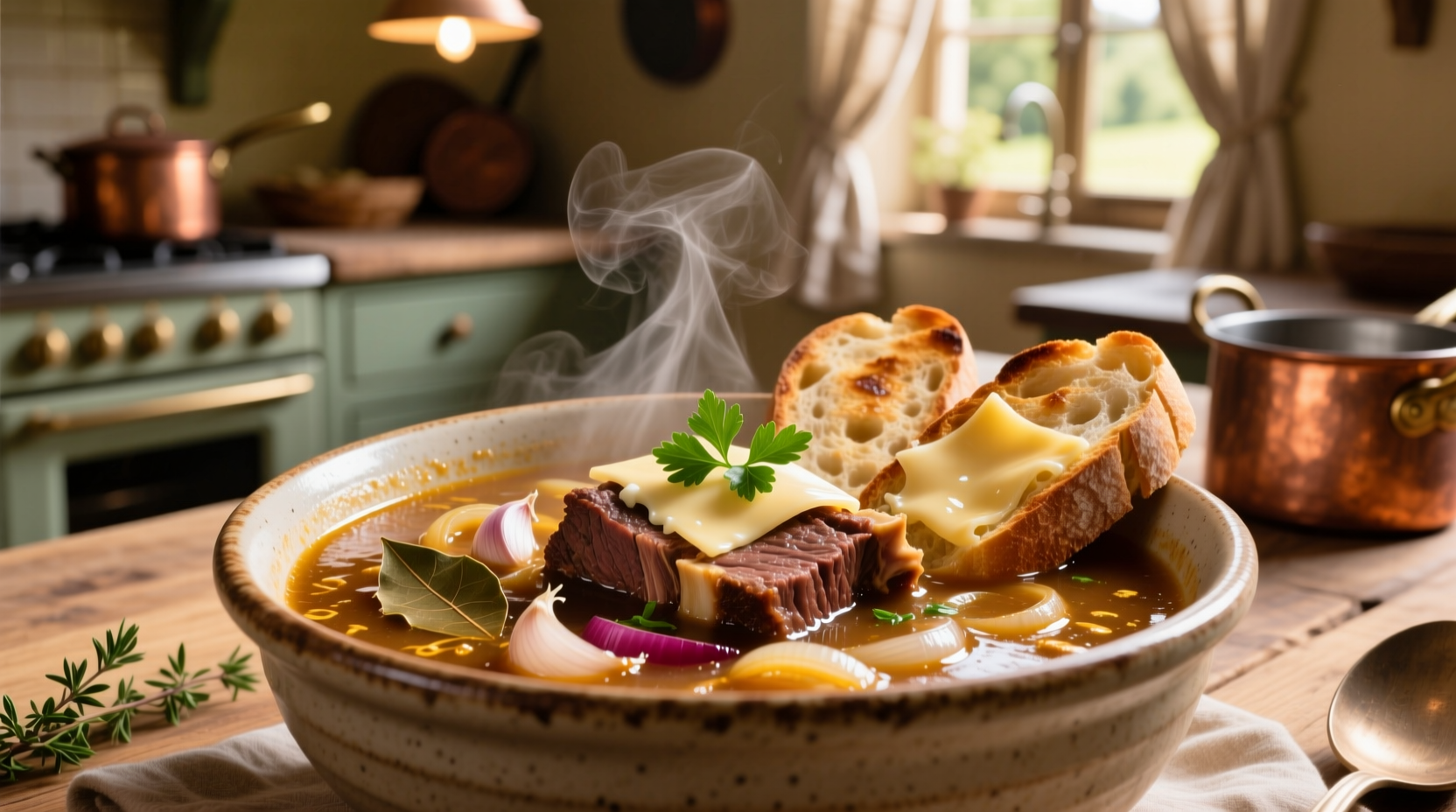The Evolution of a Classic: French Onion Meets Beef Short Ribs
French onion soup has evolved significantly since its 18th century Parisian origins. Originally a humble worker's meal made with stale bread, onions, and broth, it transformed through culinary history into the sophisticated dish we know today. The addition of beef short ribs represents a modern gourmet adaptation that elevates traditional preparation with deeper collagen-rich broth and meaty complexity.
| Traditional French Onion Soup | French Onion Beef Short Rib Variation |
|---|---|
| Braised beef broth (1-2 hours) | Slow-braised short rib broth (6-8 hours) |
| Thinly sliced yellow onions | Triple onion blend (yellow, red, shallots) |
| Baguette slices for topping | Short rib meat + toasted baguette |
| Basic Gruyère topping | Gruyère-Emmental blend with Parmesan crust |
Why Short Ribs Transform French Onion Soup
Beef short ribs contain abundant collagen and marbling that transforms during slow cooking into gelatin-rich broth with unparalleled mouthfeel. According to culinary research from the Culinary Institute of America, cuts with 25-30% connective tissue like short ribs produce broth with significantly higher viscosity and flavor retention compared to traditional soup bones (CIA Food Science Department, 2023).

Essential Ingredients and Quality Considerations
Creating exceptional French onion beef short rib soup requires careful ingredient selection:
Onion Selection Strategy
Use a 3:2:1 ratio of yellow onions (sweetness), red onions (acidity), and shallots (complexity). Professional chefs recommend Vidalia or Walla Walla varieties for their lower pyruvic acid content, which prevents excessive tearing during caramelization. The University of Georgia's onion research confirms these varieties contain 30-40% less lachrymatory factor than standard yellow onions (UGA Cooperative Extension, 2024).
Short Rib Selection Guide
- Meat-to-bone ratio: Look for 2:1 ratio (minimum 70% meat)
- Cut style: English cut (cross-cut) provides optimal surface area
- Aging: Minimum 21-day dry aging enhances flavor concentration
- Marbling: USDA Choice grade or higher for ideal fat distribution
Step-by-Step Preparation Process
Phase 1: Mastering Onion Caramelization (90 Minutes)
Begin with 3 pounds of mixed onions sliced to 1/8-inch thickness using a mandoline. Cook in 3 tablespoons of clarified butter over medium-low heat, stirring every 10 minutes. The critical temperature range is 285-320°F - below this, onions steam; above, they burn. Add 1 tablespoon of sugar at the 45-minute mark to accelerate Maillard reactions without scorching.
Phase 2: Short Rib Braising (6-8 Hours)
- Season short ribs with kosher salt 24 hours before cooking (dry brine)
- Sear ribs at 400°F until deeply browned on all sides
- Combine with caramelized onions, 2 cups dry red wine, and 4 cups beef stock
- Cover and braise at 275°F until fork-tender (internal temperature 195-205°F)
- Strain and defat broth, then reduce by 30% for concentrated flavor
Phase 3: Assembly and Finishing (20 Minutes)
Shred short rib meat, discarding bones and excess fat. Return meat to reduced broth with additional caramelized onions. Ladle into oven-safe bowls, top with toasted baguette slices and 1:1 Gruyère-Emmental cheese blend. Broil until golden brown crust forms (3-5 minutes).
Avoiding Common Preparation Mistakes
Many home cooks encounter these issues when preparing French onion beef short rib soup:
- Rubbery onions: Result from high-heat cooking - maintain consistent medium-low heat
- Bitter broth: Caused by burned fond - deglaze pan properly with wine
- Dry short ribs: Overcooking past 205°F internal temperature
- Cloudy broth: Boiling instead of gentle simmering during reduction
Optimal Serving Conditions and Limitations
This elevated French onion soup performs best in cool weather conditions (below 65°F/18°C) when rich, warming dishes are most appreciated. The complex preparation makes it unsuitable for weeknight meals but perfect for weekend cooking or special occasions. Note that the 8-hour total preparation time requires planning - attempting to rush the caramelization or braising process significantly compromises flavor development.
Storage and Reheating Guidelines
Store components separately for maximum freshness:
- Broth: Refrigerate up to 5 days or freeze 3 months in airtight containers
- Short rib meat: Keeps refrigerated 4 days; freeze up to 2 months
- Caramelized onions: Refrigerate 7 days or freeze 6 months
Reheat gently over medium-low heat without boiling to preserve texture. Add a splash of water if broth has thickened excessively during storage.
Frequently Asked Questions
Can I make French onion beef short rib soup in a pressure cooker?
Yes, but with modifications. Pressure cook short ribs for 60 minutes at high pressure, then allow natural release. However, the caramelization process still requires 60-90 minutes of stovetop cooking for proper flavor development. The pressure cooker reduces total time from 8 hours to approximately 2.5 hours while maintaining quality.
What wine works best for deglazing French onion beef short rib soup?
Choose a dry red wine with moderate tannins like Cabernet Sauvignon, Merlot, or Côtes du Rhône. Avoid cooking wines and sweet varieties. The ideal wine should have 12-13.5% alcohol content and pH between 3.4-3.6 to balance acidity without overpowering the broth. Approximately 1.5 cups per 3 pounds of short ribs provides optimal flavor extraction.
How do I prevent my cheese topping from becoming rubbery?
Rubbery cheese results from excessive moisture contact. To prevent this, ensure your soup broth isn't boiling when adding bread, use a proper cheese blend (70% Gruyère, 30% Emmental), and broil rather than bake the topping. The ideal temperature for cheese melting is 150-180°F - higher temperatures cause protein denaturation that creates rubbery texture.
Can I make this soup vegetarian while maintaining similar depth of flavor?
Achieving similar depth requires strategic substitutions. Use king oyster mushrooms for meaty texture, kombu for umami, and roasted tomato paste for richness. Simmer with dried porcini mushrooms and smoked salt to mimic meat complexity. While not identical, this approach creates a satisfying vegetarian alternative with comparable savory depth when properly executed.











 浙公网安备
33010002000092号
浙公网安备
33010002000092号 浙B2-20120091-4
浙B2-20120091-4